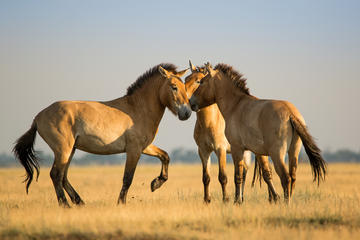
Hortobagy National Park
Found among the rolling plains of Alföld in eastern Hungary, Hortobagy National Park is UNESCO World Heritage-listed for its unique
puszta grasslands, marshes, meadows and Europe’s biggest salt plain lying close to the River Tisza. Covering 82,000 hectares, it is a landscape where time has stood still and ancient rural farming traditions are still practised.
Distinctive gray cattle with curly horns graze the grasslands along with hardy, long-horned, woolly
racka sheep and hairy mangalica pigs, shepherded by farmers who were once largely nomadic. The local
csikós – Hungarian cowboys – are known for their daredevil equestrian skills and regular riding displays are given at several stud farms in the park. Hortobagy is also a paradise for bird watchers; during fall, some 70,000 cranes break their migration in the park, where more than 340 species of bird have been spotted, including cormorants, herons and egrets.
One of the few manmade landmarks in this land of infinite horizons is the elegant Neo-classical Nine-Span Bridge, completed in 1833 across the River Hortobagy to allow easier travel between Budapest and Hungary’s second city of Debrecen. Visitor attractions in the park include a museum of shepherding, an animal sanctuary and a narrow-gauge railway through the salt marshes. A series of roadside inns known as
csárda were developed for travelers heading along the salt trading routes; these now provide low-key accommodation in the national park.
Practical Info
Hortobagy National Park Visitor Centre and Workshop: Hortobagy, Petőfi tér 13. Open May–June, Sept–Oct Mon–Fri 8am–4pm, Sat–Sun 10am–4pm; July–Aug Mon–Fri 8am–5pm, Sat–Sun 10am–5pm. Entrance to national park and attractions: adults 600 HUF; seniors & students 400 HUF; family ticket 1,600 HUF. Hortobagy is two hours 15 minutes from Budapest by car along the M3 and Route 33.
